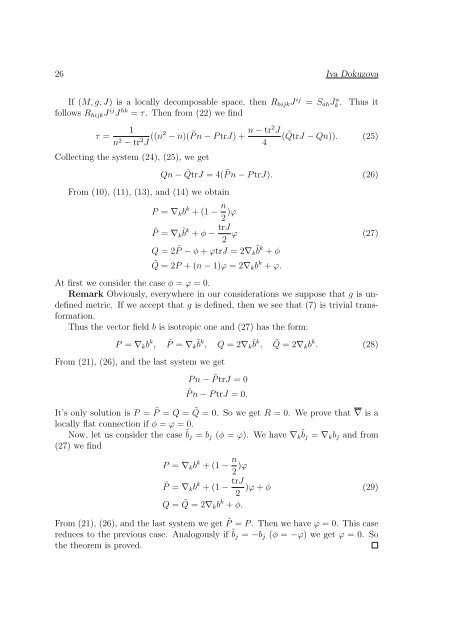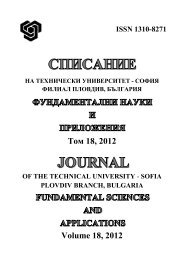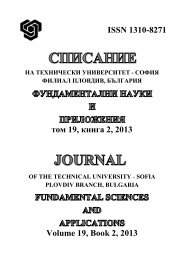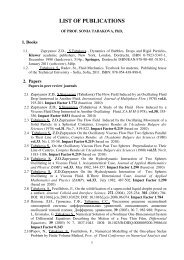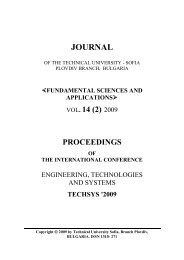JOURNAL Series A - Pure and Applied Mathematics
JOURNAL Series A - Pure and Applied Mathematics
JOURNAL Series A - Pure and Applied Mathematics
You also want an ePaper? Increase the reach of your titles
YUMPU automatically turns print PDFs into web optimized ePapers that Google loves.
26 Iva DokuzovaIf (M, g, J) is a locally decomposable space, then R hijk J ij = S ah Jk a . Thus itfollows R hijk J ij J hk = τ. Then from (22) we findτ =1n 2 − tr 2 J ((n2 − n)( ˜P n − P trJ) + n − tr2 J(4˜QtrJ − Qn)). (25)Collecting the system (24), (25), we getFrom (10), (11), (13), <strong>and</strong> (14) we obtainQn − ˜QtrJ = 4( ˜P n − P trJ). (26)P = ∇ k b k + (1 − n 2 )ϕ˜P = ∇ k˜bk + φ − trJ2 ϕ (27)Q = 2 ˜P − φ + ϕtrJ = 2∇ k˜bk + φ˜Q = 2P + (n − 1)ϕ = 2∇ k b k + ϕ.At first we consider the case φ = ϕ = 0.Remark Obviously, everywhere in our considerations we suppose that g is undefinedmetric. If we accept that g is defined, then we see that (7) is trivial transformation.Thus the vector field b is isotropic one <strong>and</strong> (27) has the form:P = ∇ k b k , ˜P = ∇k˜bk , Q = 2∇ k˜bk , ˜Q = 2∇k b k . (28)From (21), (26), <strong>and</strong> the last system we getP n − ˜P trJ = 0˜P n − P trJ = 0.It’s only solution is P = ˜P = Q = ˜Q = 0. So we get R = 0. We prove that ∇ is alocally flat connection if φ = ϕ = 0.Now, let us consider the case ˜b j = b j (φ = ϕ). We have ∇ k˜bj = ∇ k b j <strong>and</strong> from(27) we findP = ∇ k b k + (1 − n 2 )ϕ˜P = ∇ k b k + (1 − trJ )ϕ + φ (29)2Q = ˜Q = 2∇ k b k + φ.From (21), (26), <strong>and</strong> the last system we get ˜P = P . Then we have ϕ = 0. This casereduces to the previous case. Analogously if ˜b j = −b j (φ = −ϕ) we get ϕ = 0. Sothe theorem is proved.


